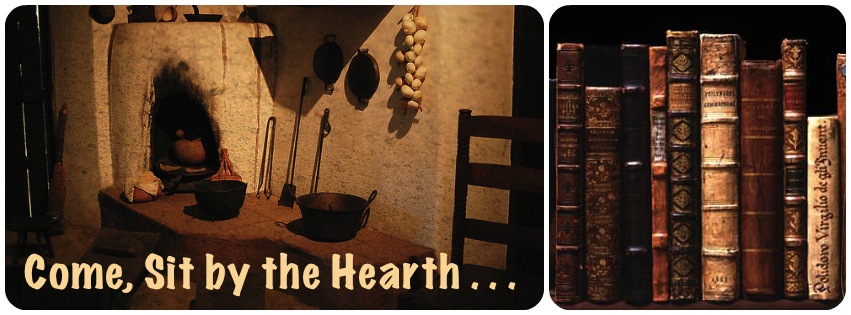Cento hails from the Latin word for 'patchwork,' and has been around since at least the 4th century. It is basically a poem made up of lines from poems by other poets. Each line must be taken from a different poem. and when the lines are put together, they must make sense. The poem doesn’t have to rhyme, but rhyming adds a nice touch. And always give credit to the poets you use.
One of my professors insisted we write these as a way of proving that we were familiar with a broad array of poetry. At first I hated it but it became a fun challenge and as an added benefit I found myself immersed in poetry I might have otherwise overlooked. (I'm sure that was entirely unintentional)
Here is a great example by Simone Muench called:
Wolf Cento
Very quick. Very intense, like a wolf |
Octavio Paz, Henri Michaux, Agnes Nemes Nagy, Joyce Mansour,
William Burroughs, Meret Oppenheim, Mary Low, Adrienne Rich, Carl Sandburg]
The twist is "Book spine poetry."
It has been around for a few years and if you google it you can find tons of examples by a wide range of people: students, teachers, children, adults. It's as easy as you want to make it.

This one is by Travis at 100 Scope Notes.
Look Who's There!
The Watcher
What Do You See?
More
People

Lorne Daniel at Writing:Place created his book spine poetry from poetry books.
What Goes On
Here and Now
A Long Continual Argument
The Poet in the World
Writing Down the Bones
Refusing Heaven
I made my own book spine poem, but technical difficulties have kept me from uploading the picture. (lost cabely thing)
It was fun playing with the books in my own library to create a poem. I think kids would really enjoy this and I can see it as a way to jump start creativity in a dry spell.
I'll admit though, it would have been more fun if I had someone to clean up the mess I made.
Do Androids Dream of Electric Sheep
Reading Lolita in Tehran
A Passionate Apprentice
Wicked
Insecure At Last
East Wind Melts the Ice
[Sources: Philip K. Dick, Azar Nafisi,

How to:
Create a Cento
1). Take the time to look through a few poetry books. Enjoy the poems.2). Find a line you especially like, and make that the first line of your patchwork poem. Write the poet’s last name in parentheses at the end of the line.
3). Repeat #2. Choose your lines carefully—your poem must make sense.
Some things to consider:4). And remember, at the end, list each poet’s full name. Include the name of the poem in quotes.
Try to make your poem rhyme.
Make sure the beats sound right.
Tenses should agree.
Person should agree. In other words, pick lines that have all been written in either first or third person.
1). Find a place with plenty of books: a library, home collection, or even a book store (if they'll let you).
2). Find titles that strike you and write them down – you can refer back to them later.
3). Arrange and rearrange them (in your head or on paper).
4). The Library card catalog can help you find titles with specific words or phrases that fit.


Wow. I've never heard of either of these forms of poetry, but now I am completely intrigued and enchanted! I can pretty much guarantee that as soon as I finish typing this comment, I'll be heading to the bookshelves to try my hand at it. And I'm so excited to add this to the poetry unit I'll be doing with my son homeschooling this coming year! So thank you! A million times over!
ReplyDeleteYou've made my day! I'm so happy that you've been inspired and that you'll be using this with your son. It's what I call a 'Rita Dove moment.' She believes wholeheartedly in exposing kids to poetry at a young age and in doing so without pressure. My best to you and your son.
DeleteI came here by way of Debi's blog. I really enjoyed reading about how centos are done, something I've never heard of before. I write poetry, so I was curious to see how the titles stack up next to it! Interesting, I find.
ReplyDeleteI love that you posted about Rita Dove, earlier on this month, someone I've been meaning to find more books on (harder up here in Canada). Thanks.
I love your blog, and especially that quote on the corner about writing for one's self. I think I'm going to frame it by my writing table, my creative act for the day!
I'm so glad you enjoyed the posts. Poetry has been an important part of my life for many years, both writing and reading. It's great to find others who share a passion for poetry. They are hard to come by. What type of poetry do you enjoy reading most? What type of poetry do you write?
DeleteThese are such cool forms of poetry!!! I've seen the book spine poetry before and I love the idea of it :) I'll have to try my hand at it! I love love love your poem! It's quite beautiful actually :)
ReplyDeleteThank you so very much. It was fun to do. I can just imagine how great it would be to play in a big library creating poems! (until they threw me out, that is)
Delete